| Listing 1 - 8 of 8 |
Sort by
|
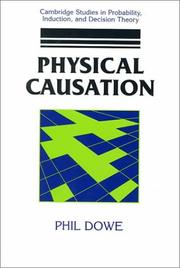
ISBN: 0521780497 0521039754 0511570651 9780521039758 9780521780490 Year: 2000 Publisher: Cambridge : Cambridge University Press,
Abstract | Keywords | Export | Availability | Bookmark
 Loading...
Loading...Choose an application
- Reference Manager
- EndNote
- RefWorks (Direct export to RefWorks)
This book, published in 2000, is a clear account of causation based firmly in contemporary science. Dowe discusses in a systematic way, a positive account of causation: the conserved quantities account of causal processes which he has been developing over the last ten years. The book describes causal processes and interactions in terms of conserved quantities: a causal process is the worldline of an object which possesses a conserved quantity, and a causal interaction involves the exchange of conserved quantities. Further, things that are properly called cause and effect are appropriately connected by a set of causal processes and interactions. The distinction between cause and effect is explained in terms of a version of the fork theory: the direction of a certain kind of ordered pattern of events in the world. This particular version has the virtue that it allows for the possibility of backwards causation, and therefore time travel.
Causality (Physics) --- Causality --- Heisenberg uncertainty principle --- Nuclear physics --- Physics --- Quantum theory --- Philosophy --- Causality (Physics). --- Arts and Humanities --- Philosophy of science

ISBN: 9780822339014 9780822339175 0822339013 082233917X Year: 2007 Publisher: Durham : Duke University Press,
Abstract | Keywords | Export | Availability | Bookmark
 Loading...
Loading...Choose an application
- Reference Manager
- EndNote
- RefWorks (Direct export to RefWorks)
Meeting the Universe Halfway is an ambitious book with far-reaching implications for numerous fields in the natural sciences, social sciences, and humanities. In this volume, Karen Barad, theoretical physicist and feminist theorist, elaborates her theory of agential realism. Offering an account of the world as a whole rather than as composed of separate natural and social realms, agential realism is at once a new epistemology, ontology, and ethics. The starting point for Barad’s analysis is the philosophical framework of quantum physicist Niels Bohr. Barad extends and partially revises Bohr’s philosophical views in light of current scholarship in physics, science studies, and the philosophy of science as well as feminist, poststructuralist, and other critical social theories. In the process, she significantly reworks understandings of space, time, matter, causality, agency, subjectivity, and objectivity. In an agential realist account, the world is made of entanglements of “social” and “natural” agencies, where the distinction between the two emerges out of specific intra-actions. Intra-activity is an inexhaustible dynamism that configures and reconfigures relations of space-time-matter. In explaining intra-activity, Barad reveals questions about how nature and culture interact and change over time to be fundamentally misguided. And she reframes understanding of the nature of scientific and political practices and their “interrelationship.” Thus she pays particular attention to the responsible practice of science, and she emphasizes changes in the understanding of political practices, critically reworking Judith Butler’s influential theory of performativity. Finally, Barad uses agential realism to produce a new interpretation of quantum physics, demonstrating that agential realism is more than a means of reflecting on science; it can be used to actually do science.
kwantumleer --- Quantum mechanics. Quantumfield theory --- Philosophy of science --- Science --- #SBIB:316.23H2 --- #SBIB:316.23H3 --- #SBIB:1H40 --- Sociologie van de wetenschappen --- Wijsgerige grondslagen en discussie in de sociologie --- Epistemologie, methoden in de filosofie --- Physics --- Quantum theory --- Heisenberg uncertainty principle --- Realism --- Relativity (Physics) --- Matter --- Philosophy. --- Gravitation --- Nonrelativistic quantum mechanics --- Space and time --- Empiricism --- Philosophy --- Universals (Philosophy) --- Conceptualism --- Dualism --- Idealism --- Materialism --- Nominalism --- Positivism --- Rationalism --- Indeterminancy principle --- Uncertainty principle --- 694 --- Esthetica en filosofie --- Théorie quantique --- Matière --- Rapports sociaux --- Book --- Epistemology
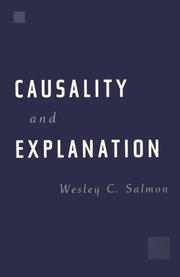
ISBN: 0195108647 0195108639 9780195108644 0199833621 019802682X 0585357625 9780195108637 Year: 1998 Publisher: New York (N.Y.): Oxford university press
Abstract | Keywords | Export | Availability | Bookmark
 Loading...
Loading...Choose an application
- Reference Manager
- EndNote
- RefWorks (Direct export to RefWorks)
Philosophy of science --- Science --- Causality (Physics) --- Explanation --- Sciences --- Causalité (Physique) --- Explication --- Philosophy --- Methodology --- Philosophie --- Méthodologie --- Explanation. --- Philosophy. --- Methodology. --- Causality (Physics). --- Normal science --- Scientific method --- Explanation (Philosophy) --- Causality --- Logic, Symbolic and mathematical --- Knowledge, Theory of --- Heisenberg uncertainty principle --- Nuclear physics --- Physics --- Quantum theory --- Science - Philosophy. --- Science - Methodology.
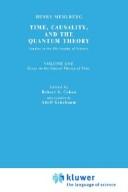
ISBN: 9027710740 9027707219 9027710759 9027710767 9400989350 9400989881 9789027710758 9789027710741 9789027707215 Year: 1980 Volume: 19 Publisher: Dordrecht Reidel
Abstract | Keywords | Export | Availability | Bookmark
 Loading...
Loading...Choose an application
- Reference Manager
- EndNote
- RefWorks (Direct export to RefWorks)
Space and time --- Causality (Physics) --- Quantum theory --- Physics --- Philosophy --- -Quantum theory --- #GROL:SEMI-113:5 --- Space of more than three dimensions --- Space-time --- Space-time continuum --- Space-times --- Spacetime --- Time and space --- Fourth dimension --- Infinite --- Metaphysics --- Space sciences --- Time --- Beginning --- Hyperspace --- Relativity (Physics) --- Quantum dynamics --- Quantum mechanics --- Quantum physics --- Mechanics --- Thermodynamics --- Natural philosophy --- Philosophy, Natural --- Physical sciences --- Dynamics --- Causality --- Heisenberg uncertainty principle --- Nuclear physics --- Quantum theory. --- Space and time. --- Philosophy. --- Causality (Physics). --- History of physics --- Quantum mechanics. Quantumfield theory --- Physics - Philosophy
Book
ISBN: 0306403978 9780306403972 Year: 1987 Publisher: New York (N.Y.): Plenum,
Abstract | Keywords | Export | Availability | Bookmark
 Loading...
Loading...Choose an application
- Reference Manager
- EndNote
- RefWorks (Direct export to RefWorks)
Quantum theory --- 530.145 --- 530.1 --- 530.145 Quantum theory --- Quantum dynamics --- Quantum mechanics --- Quantum physics --- Physics --- Mechanics --- Thermodynamics --- 530.1 Basic principles of physics --- Basic principles of physics --- Quantum mechanics. Quantumfield theory --- Quantum theory. --- Perturbation theory in quantum mechanics --- Scattering in quantum mechanics --- Quantum theory(Path Integral Method) --- WKB method in quantum mechanics --- Invariants in quantum mechanics --- Dirac's theory --- Uncertainty principle --- Oscillators(Harmonic-)
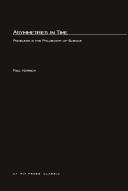
ISBN: 0262580888 0262081644 9780262580885 Year: 1988 Publisher: Cambridge (Mass.): MIT press
Abstract | Keywords | Export | Availability | Bookmark
 Loading...
Loading...Choose an application
- Reference Manager
- EndNote
- RefWorks (Direct export to RefWorks)
Philosophy of science --- Causality (Physics) --- Entropy --- Science --- Space and time --- Causality --- Heisenberg uncertainty principle --- Nuclear physics --- Physics --- Quantum theory --- Space of more than three dimensions --- Space-time --- Space-time continuum --- Space-times --- Spacetime --- Time and space --- Fourth dimension --- Infinite --- Metaphysics --- Philosophy --- Space sciences --- Time --- Beginning --- Hyperspace --- Relativity (Physics) --- Normal science --- Thermodynamics --- Space and time. --- Philosophy. --- Causality (Physics). --- Entropy. --- Science - Philosophy. --- Causalité (physique) --- Entropie --- Espace et temps --- Philosophie des sciences --- Processus irréversibles --- Temps (philosophie)
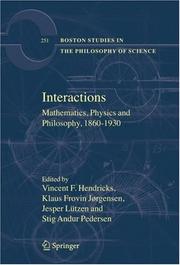
ISSN: 00680346 ISBN: 9781402051951 1402051948 9781402051944 1402051956 128074507X 9786610745074 904817306X Year: 2006 Volume: 251 Publisher: Dordrecht : Springer Netherlands : Imprint: Springer,
Abstract | Keywords | Export | Availability | Bookmark
 Loading...
Loading...Choose an application
- Reference Manager
- EndNote
- RefWorks (Direct export to RefWorks)
This is an outstanding collection of original essays. All of them concern the history and philosophy of mathematics and physics in the years from 1870 to 1930. More specifically, they are intellectual histories of the interactions between the three disciplines, philosophy, mathematics and physics, in that period. And as the essays bring out, what a period it was: of both ferment and synergy, heat and light! Most of the giants - especially Helmholtz, Hertz, Poincare, Hilbert, Einstein and Weyl - are here: engaging not just in physics and mathematics but also in philosophy, often together, or with figures like Schlick. The editors are to be congratulated on a major contribution to our understanding of one of the most complex but fertile periods in the history of all three disciplines. - Jeremy Butterfield, University of Cambridge This stimulating volume covers a wide range of topics which are of direct interest to anyone who thinks about the curious relation between mathematics and the natural world. Philosophers often pose interesting questions about the "dispensability" of mathematics to science. But they too often overlook the wealth of philosophical perplexities that can arise in detailed examples and case studies, both contemporary and historical. This volume refocuses our attention by addressing a number of topics connected to applied mathematics, any one of which is worthy of every philosopher’s attention. - James Robert Brown, University of Toronto What to make of neo-Kantianism in its hey-day, from 1840-1940? It was the most prolific of times and the most seminal, it was the most muddled and confused, it is philosophy working at its hardest with science and most damagingly against science. It is examined here episodically, as it engaged individual scientists: Helmholtz, , Hertz, Poincare, Minkowski, Hilbert, Eddington and Weyl. If Einstein is not in their number, he had to contend with their influence, and anyway he transformed their agenda. The essays on these figures are glinting in their focus and scholarship. Whatever one thinks of neo-Kantianism, this book is history and philosophy of science at its best: mathematically and physically informed, historically engaged, and philosophically driven. - Simon Saunders, University of Oxford Ten first-rate philosopher-historians probe insightfully into key conceptual questions of pre-quantum mathematical physics, from Helmholtz and Boltzmann, through Hertz and Lorentz, to Einstein, Weyl and Eddington, with an interesting aside on the rarely studied philosophy of Federigo Enriques. A rich and effective display of what the critical history of science can do for our understanding of scientific thought and its achievements. Roberto Torretti, University of Puerto Rico.
History of philosophy --- Pure sciences. Natural sciences (general) --- Theory of knowledge --- History of physics --- filosofie --- epistomologie --- Mathematics --- geschiedenis --- Philosophy of science --- wetenschapsgeschiedenis --- wiskunde --- epistemologists --- fysica --- Philosophy. --- History. --- Philosophy and science. --- Mathematics. --- Physics. --- Philosophy, general. --- History of Mathematical Sciences. --- History of Science. --- Philosophy of Science. --- History and Philosophical Foundations of Physics. --- History of Philosophy. --- Science and philosophy --- Science --- Natural philosophy --- Philosophy, Natural --- Physical sciences --- Dynamics --- Math --- Annals --- Auxiliary sciences of history --- Mental philosophy --- Humanities --- Mathematical analysis --- Physics --- Causality (Physics) --- Foundations. --- 517.1 --- Philosophy and science --- Normal science --- Logic of mathematics --- Mathematics, Logic of --- Causality --- Heisenberg uncertainty principle --- Nuclear physics --- Quantum theory --- 517.1 Mathematical analysis --- Philosophy --- Causality (Physics). --- Philosophy (General). --- Foundations
Book
ISBN: 9786613439741 1283439743 140084066X 9780691139913 0691139911 0691139903 9780691139906 9781400840663 9781283439749 6613439746 Year: 2011 Publisher: Princeton
Abstract | Keywords | Export | Availability | Bookmark
 Loading...
Loading...Choose an application
- Reference Manager
- EndNote
- RefWorks (Direct export to RefWorks)
"Optics--a field of physics focusing on the study of light--is also central to many areas of biology, including vision, ecology, botany, animal behavior, neurobiology, and molecular biology. The Optics of Life introduces the fundamentals of optics to biologists and non-physicists, giving them the tools they need to successfully incorporate optical measurements and principles into their research. S©œnke Johnsen starts with the basics, describing the properties of light and the units and geometry of measurement. He then explores how light is created and propagates and how it interacts with matter, covering topics such as absorption, scattering, fluorescence, and polarization. Johnsen also provides a tutorial on how to measure light as well as an informative discussion of quantum mechanics. The Optics of Life features a host of examples drawn from nature and everyday life, and several appendixes that offer further practical guidance for researchers. This concise book uses a minimum of equations and jargon, explaining the basic physics of light in a succinct and lively manner. It is the essential primer for working biologists and for anyone seeking an accessible introduction to optics"--
Photobiology. --- Physiological optics. --- Polarization (Light) --- Rotation of the plane of polarization --- Optics, Physiological --- Optical Phenomena. --- Light. --- Electromagnetic waves --- Optics --- Wave-motion, Theory of --- Optical rotation --- Stereochemistry --- Vision --- Biology --- Light --- Photochemistry --- Polarization --- Visible Radiation --- Light, Visible --- Photoradiation --- Radiation, Visible --- Photoradiations --- Radiations, Visible --- Visible Light --- Visible Radiations --- Photobiology --- Optical Phenomenon --- Optical Process --- Optical Concepts --- Optical Processes --- Concept, Optical --- Concepts, Optical --- Optical Concept --- Phenomena, Optical --- Phenomenon, Optical --- Process, Optical --- Processes, Optical --- Optics. Quantum optics --- Ophthalmology --- Physiological optics --- Light sources --- Spectrum analysis --- absorption. --- animal vision. --- bioluminescence. --- coherent scattering. --- color. --- elastic scattering. --- electric field. --- electrons. --- fluorescence. --- geometry. --- human vision. --- inelastic scattering. --- integrated measurements. --- irradiance. --- light emission. --- light measurement. --- light. --- luminescence. --- lux. --- magnetic field. --- matter. --- mechanoluminescence. --- optical energy. --- optical measurements. --- optics. --- particles. --- phosphorescence. --- photon energy. --- photons. --- photosynthetically active radiation. --- polarization. --- polarized light. --- quantum entanglement. --- quantum mechanics. --- radiance. --- reflection. --- refraction. --- scattering. --- single scattering. --- sonoluminescence. --- spectra. --- spectral measurements. --- spectrometers. --- spectroradiometer. --- sun. --- thermal radiation. --- two-slit interference. --- uncertainty principle. --- units. --- wave interference. --- wave-particle duality. --- wavelength. --- waves.
| Listing 1 - 8 of 8 |
Sort by
|

 Search
Search Feedback
Feedback About
About Help
Help News
News